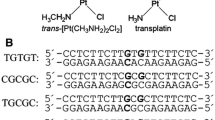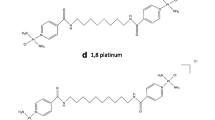Abstract
Dinuclear platinum complexes are currently undergoing pre-clinical evaluation. The development of this series has been driven by the hypothesis that a different spectrum of antitumor activity in comparison to that of cisplatin (cis-[PtCl2(NH3)2], cis-DDP) will be achieved by altering the mode of DNA binding relative to that of cisplatin and its analogues. Dinuclear platinum complexes form a unique array of DNA adducts including (Pt, Pt) interstrand and (Pt, Pt) intrastrand cross-links. A (Pt, Pt) intrastrand adduct between two adjacent guanines is the structural analog of the major adduct formed by cis-DDP2. This cis-DDP-d(GpG) adduct produces a rigid, directed bend 30-35° into the major groove of DNA, confirmed by both X- ray and NMR structural determinations on oligonucleotide fragments containing site-specific adducts3, 4. This bend is recognised by damage recognition proteins containing the HMG-binding domain5. In contrast, the global structural distortions of DNA induced by the dinuclear platinum complexes are recognized only weakly by HMG-domain proteins.6 This contribution summarises our results on the structural reasons for these differences, as exemplified by comparative studies on DNA-DNA intrastrand adducts between adjacent guanines.
Access this chapter
Tax calculation will be finalised at checkout
Purchases are for personal use only
Preview
Unable to display preview. Download preview PDF.
Similar content being viewed by others
References
Farrell, N. (1995) DNA Binding and Chemistry of Dinuclear Platinum Complexes, Comments in Inorganic Chemistry, 16, 373–389.
Bloemink, M.J. and Reedijk, J. (1996) Cisplatin and Derived Anticancer Drugs: Mechanism and Current Status of DNA Binding. Metal Ions in Biological Systems, 32, 641–685.
Takahara, P.M.; Rosenzweig, A.C.; Frederick, C.A. and Lippard, S.J. (1995) Crystal Structure of double-stranded DNA containing the major adduct of the anticancer drug cisplatin, Nature, 377, 649–657.
Yang, D.; van Boom. S.S.G.E.; Reedijk, J.; van Boom. J.H. and Wang, A.H.-J. (1995) Structure and Isomerization of an Interstrand Cisplatin-Cross-Linked Octamer DNA Duplex by NMR Analysis. Biochemistry, 34, 12917–12920.
Whitehead, J.P. and Lippard, S.J. (1996) Proteins that Bind to and Mediate the Biological Activity of Platinum Anticancer Drug-DNA Adducts, Metal Ions in Biological Systems, 32, 687–776.
Farrell, N., Appleton, T.G., Qu, Y., Roberts, J.D., Soares Fontes, A.P., Skov, K.A., Wu, P. and Zou, Y. (1995) Effects of Geometric Isomerism and Ligand Substitution in Bifunctional Dinuclear Platinum Complexes on Binding Properties and Conformational Changes in DNA, Biochemistry, 34, 15480–15486.
Kasparkova, J., Mellish, K.J., Qu, Y., Brabec, V. and Farrell, N. Site-Specific d(GpG) Intrastrand Cross-links Formed By Dinuclear Platinum Complexes, Bending and NMR Studies, Biochemistry, In Press.
Qu, Y., Bloemink, M.J., Reedijk, J., Hambley, T.W., and Farrell, N. (1996) Dinuclear Platinum Complexes Form a Novel Intrastrand Adduct with d(GpG)-an anti-syn conformation of the macrochelate as observed by MR and molecular modeling. J. Am. Chem. Soc. 118, 9307–9313.
Spellmeyer Fouls, C., Marzilli, L.G., Byrd, R.A., Summers, M.F., Zon, G. and Shinozuka, K. (1988) HMQC and 1H and 31 P NMR Studies of Platinum Amine Adducts of Tetradeoxyribonucleotides. Relationship Between 31P Shift and Potential Hydrogen-Bonding Interactions in pGpG Moieties Cross-linked byPlatinum, Iuorg Chem. 27, 366–376.
Mellish, K.J., Qu, Y. and Farrell, N. Effect of Geometric Inomerism in Dinuclar Platinum Antitumor Complexes on the Rate of Formation and Structure of Intrastrand Adducts with Oligonucleotides, Nuc. Acids Res., Submitted.
Qu, Y. and Farrell, N. (1991) Interaction of Bis(platinum) Complexes with the Mononucleotide 5′-Guanosine Monophosphate (5′-GMP). ERffect of Diamine Linker and the Nature of the Bis(platinum) Complex on Product Formation, J. Am. Chem. Soc., 113, 4851–4856.
Van Houten, B., Illenye, S., Qu, Y. and Farrell, N. (1993) Homodinuclear (Pt, Pt) and Heterodinuclear (Ru, Pt) Metal Complexes as DNA-Protein Cross-linking Agents: Potential Suicide DNA Lesions. Biochemistry 32, 11794–11801.
Farrell, N. (1993) Non-classical Platinum Antitumor Complexes. Perspectives for Design and Development of New Drugs Complementary to Cisplatin, Cancer Investigation, 11, 578–589.
Yohannes, P.G.; Zon, G.; Doetsch, P.W. and Marzilli, L.G. (1993) DNA Hairpin Formation in Adducts with Platinum Anticancer Drugs: Gel Electrophoresis Provides New Information and a Caveat, J. Am. Chem. Soc., 115, 5105–5110.
Huaug, H.; Zhu, L.; Reid, B.R.; Drobny, G.P. and Hopkins, P.B. (1995) Solution Structure of a Cisplatin-Induced DNA Interstrand Cross-link, Science, 270, 1842–1845.
Yang, D., Van Boom, S.S.G.E., Reedijk, J., Van Boom, J.H., Farrell, N. and Wang, A.H.-J. (1995) A novel DNA structure induced by the new dinuclear anticancer compound μ-(1, 4-diamiuobutane)-bis[traus-diamminechloroplatinum(II)] crosslinked to a GpG site in DNA, Nat Struct Biol., 2, 577–586.
Kharatishvili, M.; Qu, Y. and Farrell, N. Z-DNA Formation by Dinuclear Platinum Complexes is Irreversible, Nuc. Acids Res., Submitted.
Author information
Authors and Affiliations
Editor information
Editors and Affiliations
Rights and permissions
Copyright information
© 1997 Springer Science+Business Media Dordrecht
About this chapter
Cite this chapter
Qu, Y., Bloemink, M.J., Mellish, K.J., Rauter, H., Smeds, K.A., Farrell, N. (1997). Factors Affecting Formation and Structure of DNA Intrastrand Cross-Links by Dinuclear Platinum Complexes. In: Hadjiliadis, N.D. (eds) Cytotoxic, Mutagenic and Carcinogenic Potential of Heavy Metals Related to Human Environment. NATO ASI Series, vol 26. Springer, Dordrecht. https://doi.org/10.1007/978-94-011-5780-3_26
Download citation
DOI: https://doi.org/10.1007/978-94-011-5780-3_26
Publisher Name: Springer, Dordrecht
Print ISBN: 978-94-010-6440-8
Online ISBN: 978-94-011-5780-3
eBook Packages: Springer Book Archive




